Attached files
| file | filename |
|---|---|
| 8-K - 8-K - 2Q 2017 INVESTOR PRESENTATION - GETTY REALTY CORP /MD/ | gty-8k_20170727.htm |
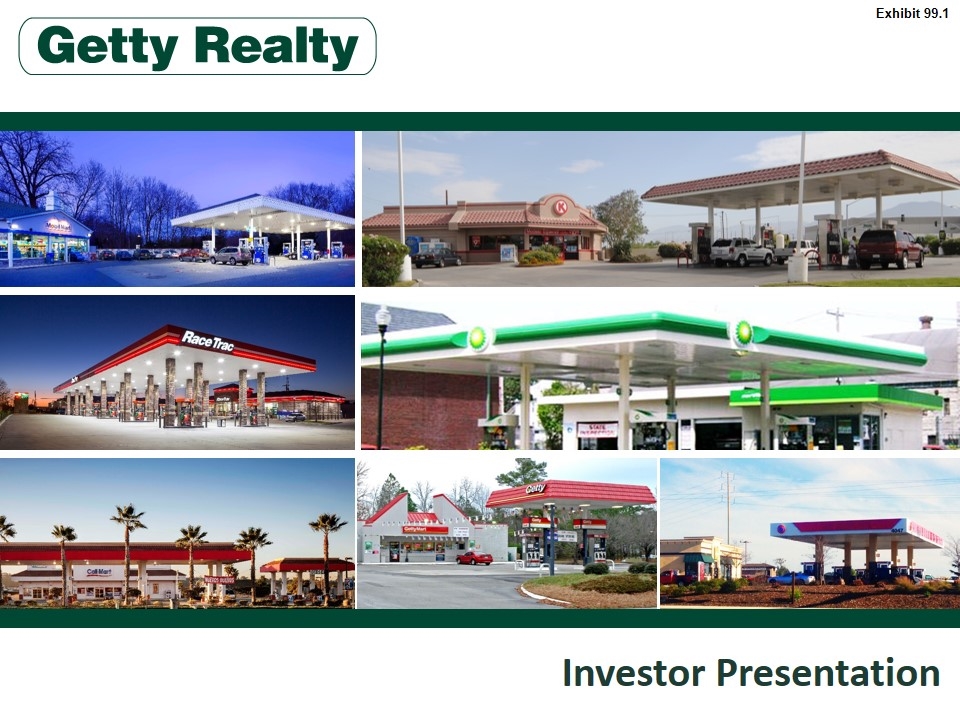
Investor Presentation Exhibit 99.1
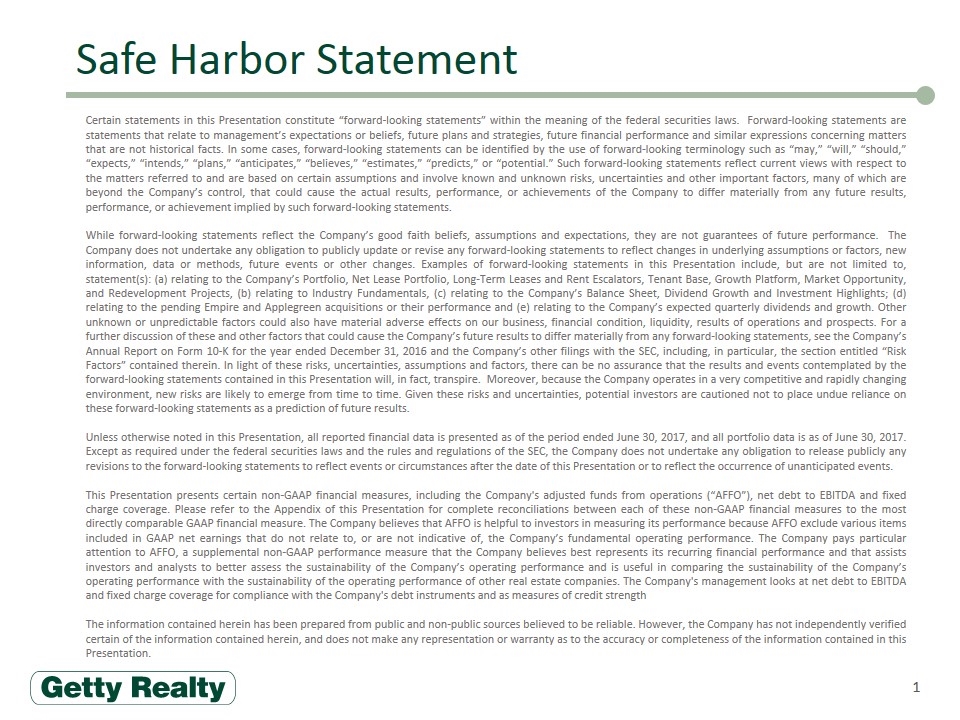
Safe Harbor Statement 1 Certain statements in this Presentation constitute “forward-looking statements” within the meaning of the federal securities laws. Forward-looking statements are statements that relate to management’s expectations or beliefs, future plans and strategies, future financial performance and similar expressions concerning matters that are not historical facts. In some cases, forward-looking statements can be identified by the use of forward-looking terminology such as “may,” “will,” “should,” “expects,” “intends,” “plans,” “anticipates,” “believes,” “estimates,” “predicts,” or “potential.” Such forward-looking statements reflect current views with respect to the matters referred to and are based on certain assumptions and involve known and unknown risks, uncertainties and other important factors, many of which are beyond the Company’s control, that could cause the actual results, performance, or achievements of the Company to differ materially from any future results, performance, or achievement implied by such forward-looking statements. While forward-looking statements reflect the Company’s good faith beliefs, assumptions and expectations, they are not guarantees of future performance. The Company does not undertake any obligation to publicly update or revise any forward-looking statements to reflect changes in underlying assumptions or factors, new information, data or methods, future events or other changes. Examples of forward-looking statements in this Presentation include, but are not limited to, statement(s): (a) relating to the Company’s Portfolio, Net Lease Portfolio, Long-Term Leases and Rent Escalators, Tenant Base, Growth Platform, Market Opportunity, and Redevelopment Projects, (b) relating to Industry Fundamentals, (c) relating to the Company’s Balance Sheet, Dividend Growth and Investment Highlights; (d) relating to the pending Empire and Applegreen acquisitions or their performance and (e) relating to the Company’s expected quarterly dividends and growth. Other unknown or unpredictable factors could also have material adverse effects on our business, financial condition, liquidity, results of operations and prospects. For a further discussion of these and other factors that could cause the Company’s future results to differ materially from any forward-looking statements, see the Company’s Annual Report on Form 10-K for the year ended December 31, 2016 and the Company’s other filings with the SEC, including, in particular, the section entitled “Risk Factors” contained therein. In light of these risks, uncertainties, assumptions and factors, there can be no assurance that the results and events contemplated by the forward-looking statements contained in this Presentation will, in fact, transpire. Moreover, because the Company operates in a very competitive and rapidly changing environment, new risks are likely to emerge from time to time. Given these risks and uncertainties, potential investors are cautioned not to place undue reliance on these forward-looking statements as a prediction of future results. Unless otherwise noted in this Presentation, all reported financial data is presented as of the period ended June 30, 2017, and all portfolio data is as of June 30, 2017. Except as required under the federal securities laws and the rules and regulations of the SEC, the Company does not undertake any obligation to release publicly any revisions to the forward-looking statements to reflect events or circumstances after the date of this Presentation or to reflect the occurrence of unanticipated events. This Presentation presents certain non-GAAP financial measures, including the Company's adjusted funds from operations (“AFFO”), net debt to EBITDA and fixed charge coverage. Please refer to the Appendix of this Presentation for complete reconciliations between each of these non-GAAP financial measures to the most directly comparable GAAP financial measure. The Company believes that AFFO is helpful to investors in measuring its performance because AFFO exclude various items included in GAAP net earnings that do not relate to, or are not indicative of, the Company’s fundamental operating performance. The Company pays particular attention to AFFO, a supplemental non-GAAP performance measure that the Company believes best represents its recurring financial performance and that assists investors and analysts to better assess the sustainability of the Company’s operating performance and is useful in comparing the sustainability of the Company’s operating performance with the sustainability of the operating performance of other real estate companies. The Company's management looks at net debt to EBITDA and fixed charge coverage for compliance with the Company's debt instruments and as measures of credit strength The information contained herein has been prepared from public and non-public sources believed to be reliable. However, the Company has not independently verified certain of the information contained herein, and does not make any representation or warranty as to the accuracy or completeness of the information contained in this Presentation.
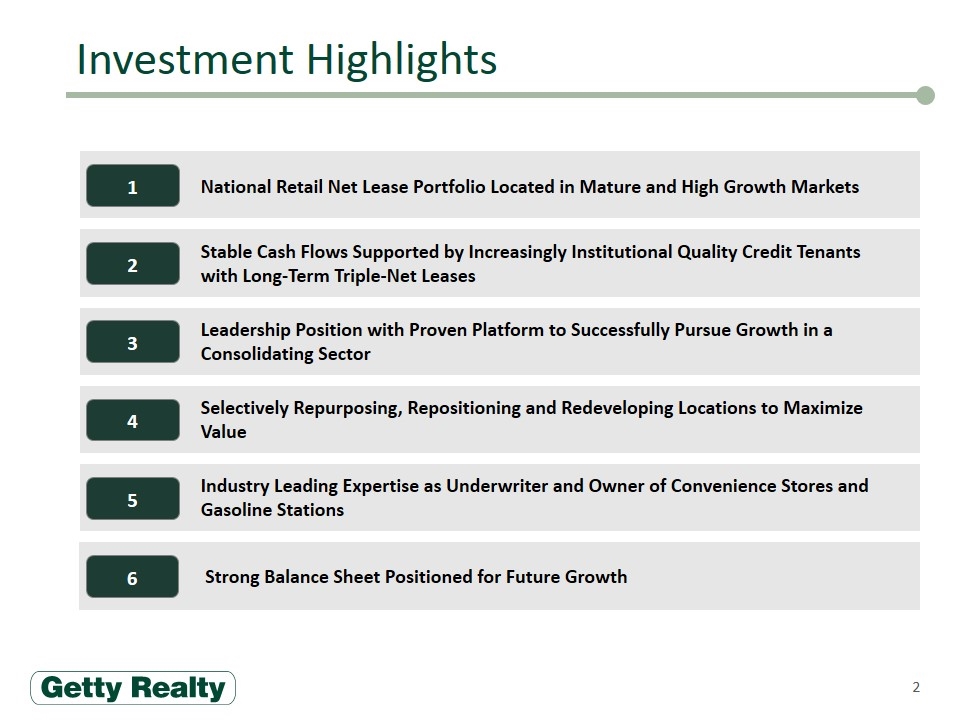
Investment Highlights 2 1 National Retail Net Lease Portfolio Located in Mature and High Growth Markets 2 Stable Cash Flows Supported by Increasingly Institutional Quality Credit Tenants with Long-Term Triple-Net Leases 5 Industry Leading Expertise as Underwriter and Owner of Convenience Stores and Gasoline Stations 3 4 Selectively Repurposing, Repositioning and Redeveloping Locations to Maximize Value 6 Strong Balance Sheet Positioned for Future Growth Leadership Position with Proven Platform to Successfully Pursue Growth in a Consolidating Sector
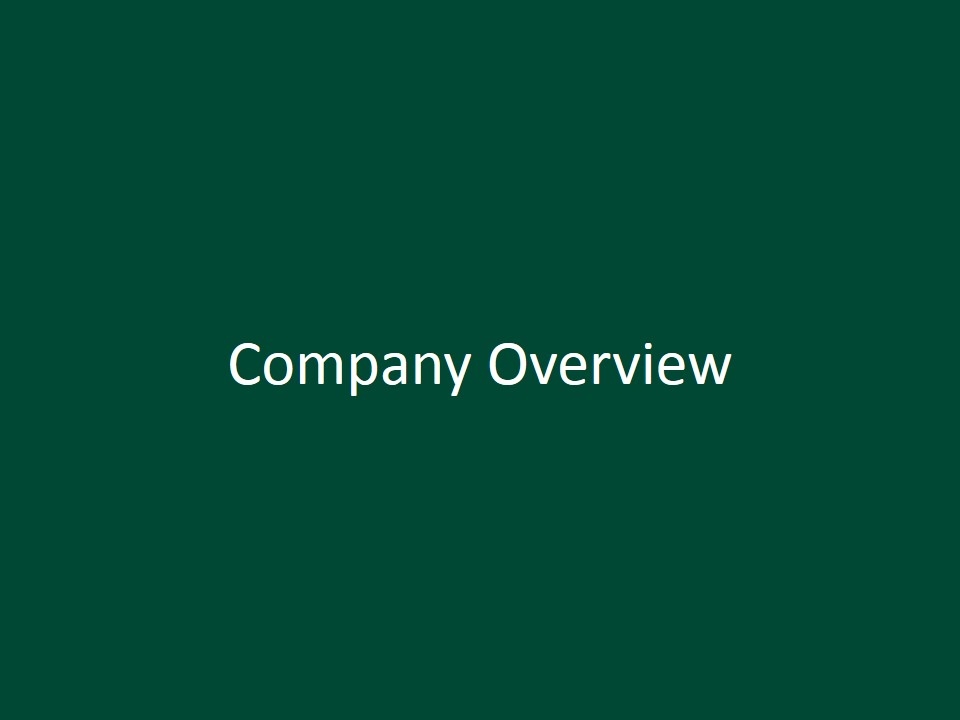
Company Overview
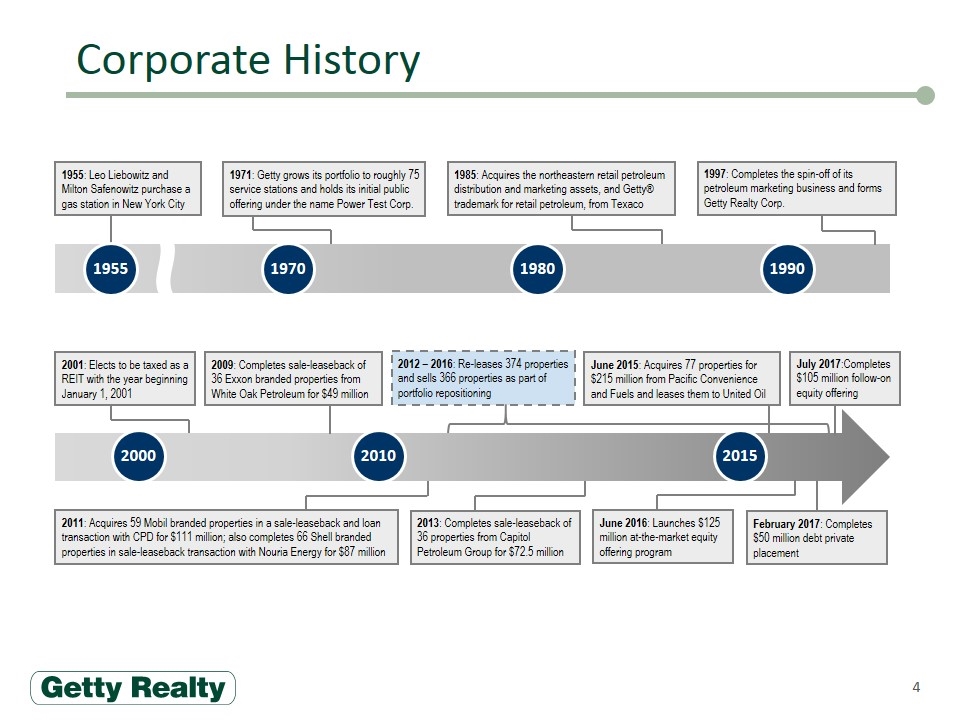
Corporate History 1955: Leo Liebowitz and Milton Safenowitz purchase a gas station in New York City 1985: Acquires the northeastern retail petroleum distribution and marketing assets, and Getty® trademark for retail petroleum, from Texaco 1971: Getty grows its portfolio to roughly 75 service stations and holds its initial public offering under the name Power Test Corp. 1990 1980 1955 1970 June 2016: Launches $125 million at-the-market equity offering program 2015 2010 2000 2001: Elects to be taxed as a REIT with the year beginning January 1, 2001 June 2015: Acquires 77 properties for $215 million from Pacific Convenience and Fuels and leases them to United Oil 2009: Completes sale-leaseback of 36 Exxon branded properties from White Oak Petroleum for $49 million 2011: Acquires 59 Mobil branded properties in a sale-leaseback and loan transaction with CPD for $111 million; also completes 66 Shell branded properties in sale-leaseback transaction with Nouria Energy for $87 million 1997: Completes the spin-off of its petroleum marketing business and forms Getty Realty Corp. 2013: Completes sale-leaseback of 36 properties from Capitol Petroleum Group for $72.5 million February 2017: Completes $50 million debt private placement 2012 – 2016: Re-leases 374 properties and sells 366 properties as part of portfolio repositioning July 2017:Completes $105 million follow-on equity offering
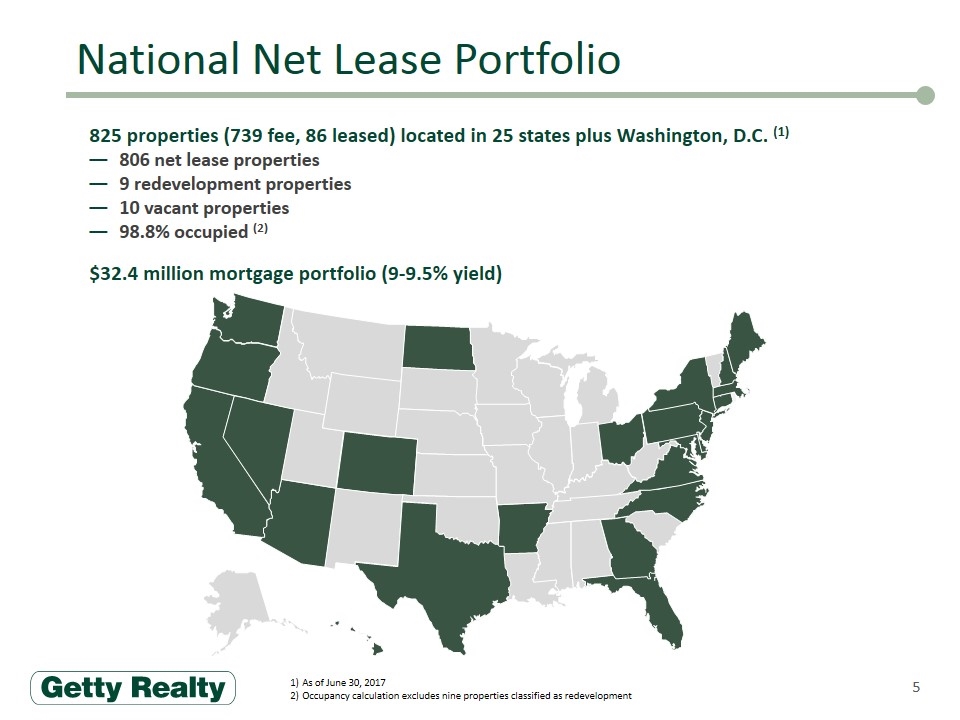
National Net Lease Portfolio 825 properties (739 fee, 86 leased) located in 25 states plus Washington, D.C. (1) 806 net lease properties 9 redevelopment properties 10 vacant properties 98.8% occupied (2) $32.4 million mortgage portfolio (9-9.5% yield) As of June 30, 2017 Occupancy calculation excludes nine properties classified as redevelopment

Investment Overview
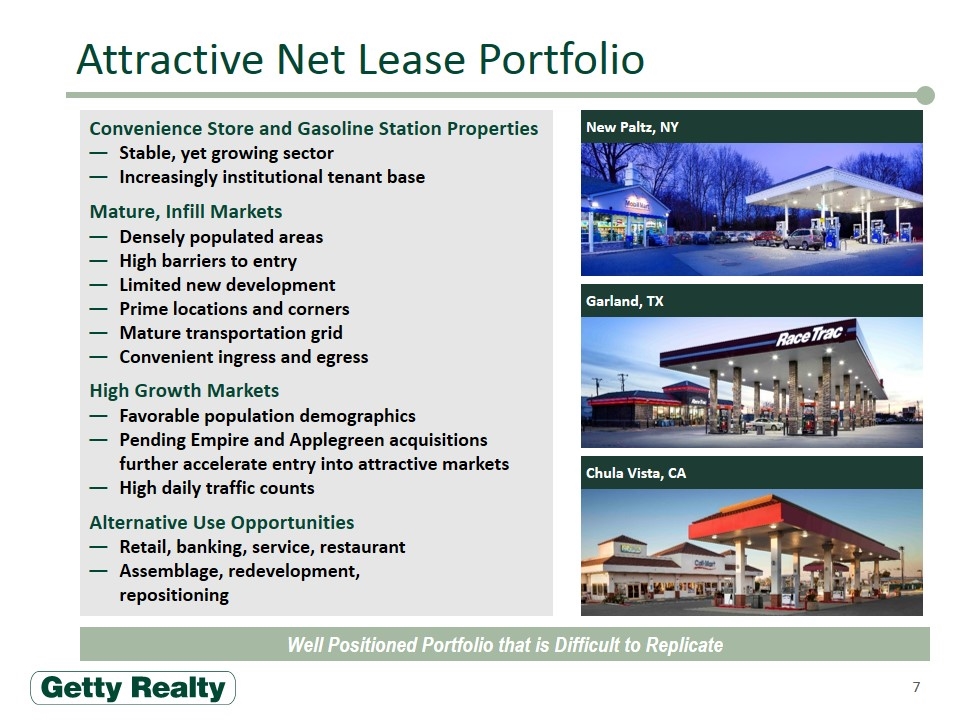
Convenience Store and Gasoline Station Properties Stable, yet growing sector Increasingly institutional tenant base Mature, Infill Markets Densely populated areas High barriers to entry Limited new development Prime locations and corners Mature transportation grid Convenient ingress and egress High Growth Markets Favorable population demographics Pending Empire and Applegreen acquisitions further accelerate entry into attractive markets High daily traffic counts Alternative Use Opportunities Retail, banking, service, restaurant Assemblage, redevelopment, repositioning Garland, TX Chula Vista, CA New Paltz, NY Attractive Net Lease Portfolio Well Positioned Portfolio that is Difficult to Replicate
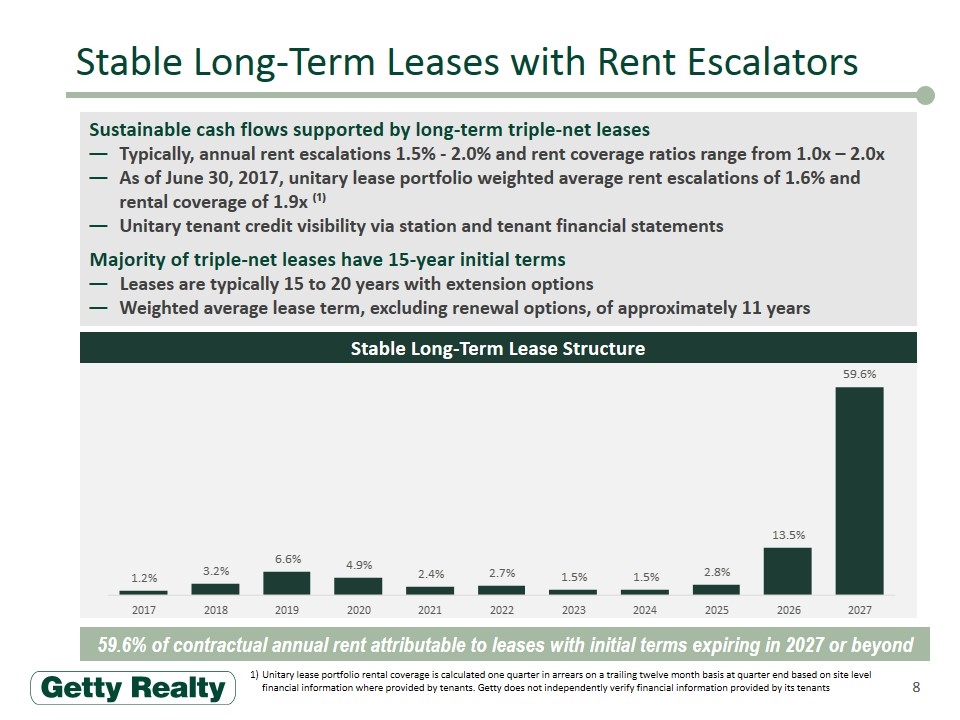
Sustainable cash flows supported by long-term triple-net leases Typically, annual rent escalations 1.5% - 2.0% and rent coverage ratios range from 1.0x – 2.0x As of June 30, 2017, unitary lease portfolio weighted average rent escalations of 1.6% and rental coverage of 1.9x ⁽¹⁾ Unitary tenant credit visibility via station and tenant financial statements Majority of triple-net leases have 15-year initial terms Leases are typically 15 to 20 years with extension options Weighted average lease term, excluding renewal options, of approximately 11 years 59.6% of contractual annual rent attributable to leases with initial terms expiring in 2027 or beyond Stable Long-Term Lease Structure Stable Long-Term Leases with Rent Escalators Unitary lease portfolio rental coverage is calculated one quarter in arrears on a trailing twelve month basis at quarter end based on site level financial information where provided by tenants. Getty does not independently verify financial information provided by its tenants
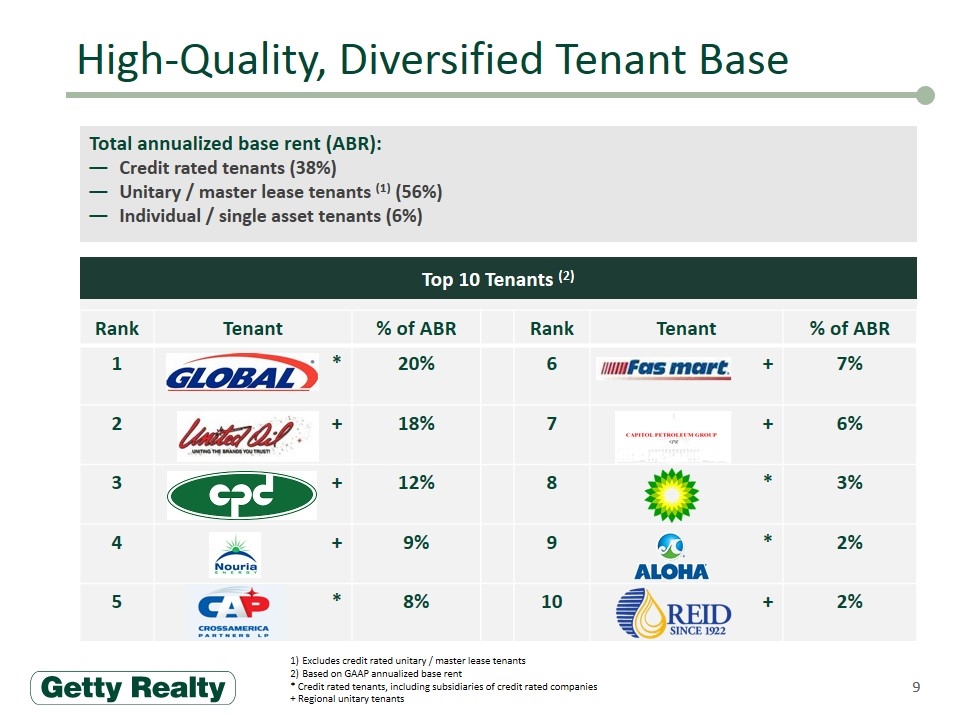
Top 10 Tenants (2) High-Quality, Diversified Tenant Base Total annualized base rent (ABR): Credit rated tenants (38%) Unitary / master lease tenants (1) (56%) Individual / single asset tenants (6%) Rank Tenant % of ABR Rank Tenant % of ABR 1 * 20% 6 + 7% 2 + 18% 7 + 6% 3 + 12% 8 * 3% 4 + 9% 9 * 2% 5 * 8% 10 + 2% Excludes credit rated unitary / master lease tenants Based on GAAP annualized base rent * Credit rated tenants, including subsidiaries of credit rated companies + Regional unitary tenants
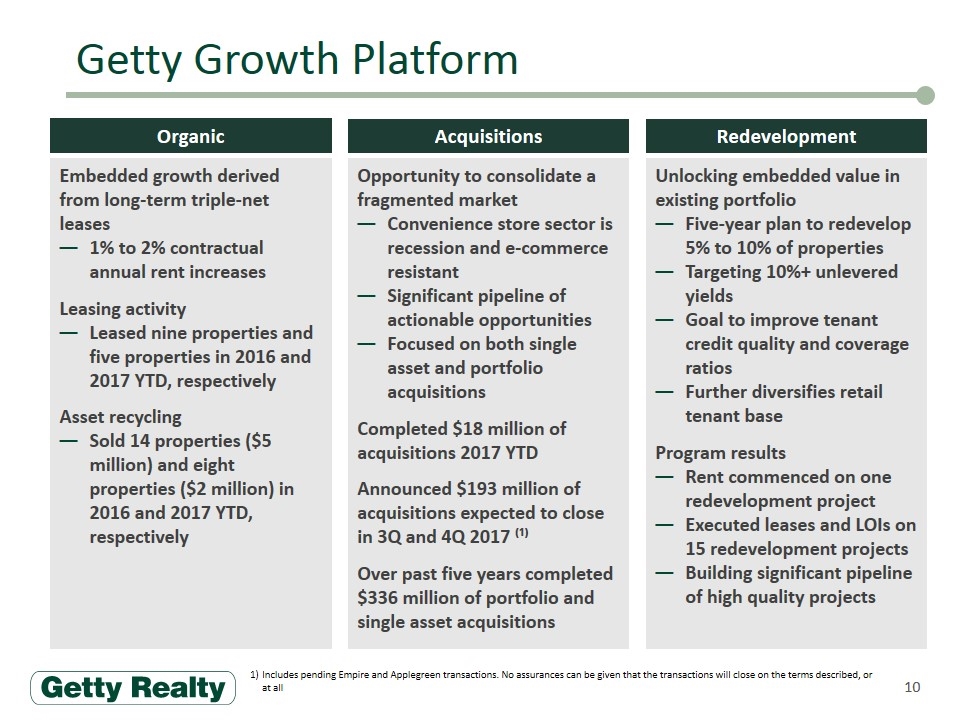
Getty Growth Platform Embedded growth derived from long-term triple-net leases 1% to 2% contractual annual rent increases Leasing activity Leased nine properties and five properties in 2016 and 2017 YTD, respectively Asset recycling Sold 14 properties ($5 million) and eight properties ($2 million) in 2016 and 2017 YTD, respectively Unlocking embedded value in existing portfolio Five-year plan to redevelop 5% to 10% of properties Targeting 10%+ unlevered yields Goal to improve tenant credit quality and coverage ratios Further diversifies retail tenant base Program results Rent commenced on one redevelopment project Executed leases and LOIs on 15 redevelopment projects Building significant pipeline of high quality projects Opportunity to consolidate a fragmented market Convenience store sector is recession and e-commerce resistant Significant pipeline of actionable opportunities Focused on both single asset and portfolio acquisitions Completed $18 million of acquisitions 2017 YTD Announced $193 million of acquisitions expected to close in 3Q and 4Q 2017 ⁽¹⁾ Over past five years completed $336 million of portfolio and single asset acquisitions Organic Acquisitions Redevelopment Includes pending Empire and Applegreen transactions. No assurances can be given that the transactions will close on the terms described, or at all
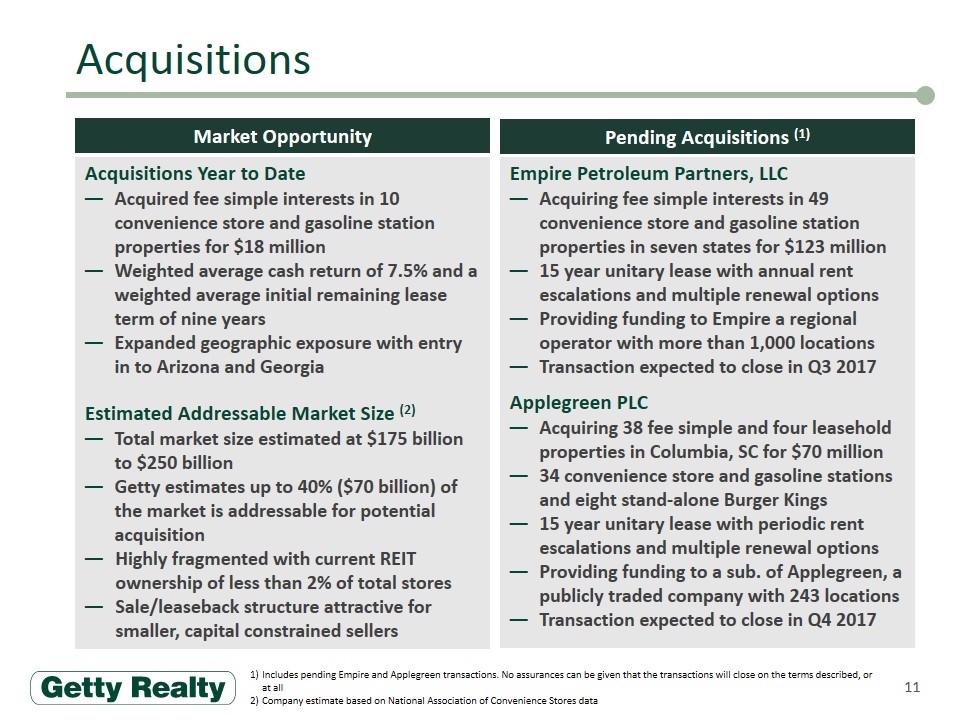
Acquisitions Acquisitions Year to Date Acquired fee simple interests in 10 convenience store and gasoline station properties for $18 million Weighted average cash return of 7.5% and a weighted average initial remaining lease term of nine years Expanded geographic exposure with entry in to Arizona and Georgia Estimated Addressable Market Size (2) Total market size estimated at $175 billion to $250 billion Getty estimates up to 40% ($70 billion) of the market is addressable for potential acquisition Highly fragmented with current REIT ownership of less than 2% of total stores Sale/leaseback structure attractive for smaller, capital constrained sellers Empire Petroleum Partners, LLC Acquiring fee simple interests in 49 convenience store and gasoline station properties in seven states for $123 million 15 year unitary lease with annual rent escalations and multiple renewal options Providing funding to Empire a regional operator with more than 1,000 locations Transaction expected to close in Q3 2017 Applegreen PLC Acquiring 38 fee simple and four leasehold properties in Columbia, SC for $70 million 34 convenience store and gasoline stations and eight stand-alone Burger Kings 15 year unitary lease with periodic rent escalations and multiple renewal options Providing funding to a sub. of Applegreen, a publicly traded company with 243 locations Transaction expected to close in Q4 2017 Market Opportunity Pending Acquisitions (1) Includes pending Empire and Applegreen transactions. No assurances can be given that the transactions will close on the terms described, or at all Company estimate based on National Association of Convenience Stores data
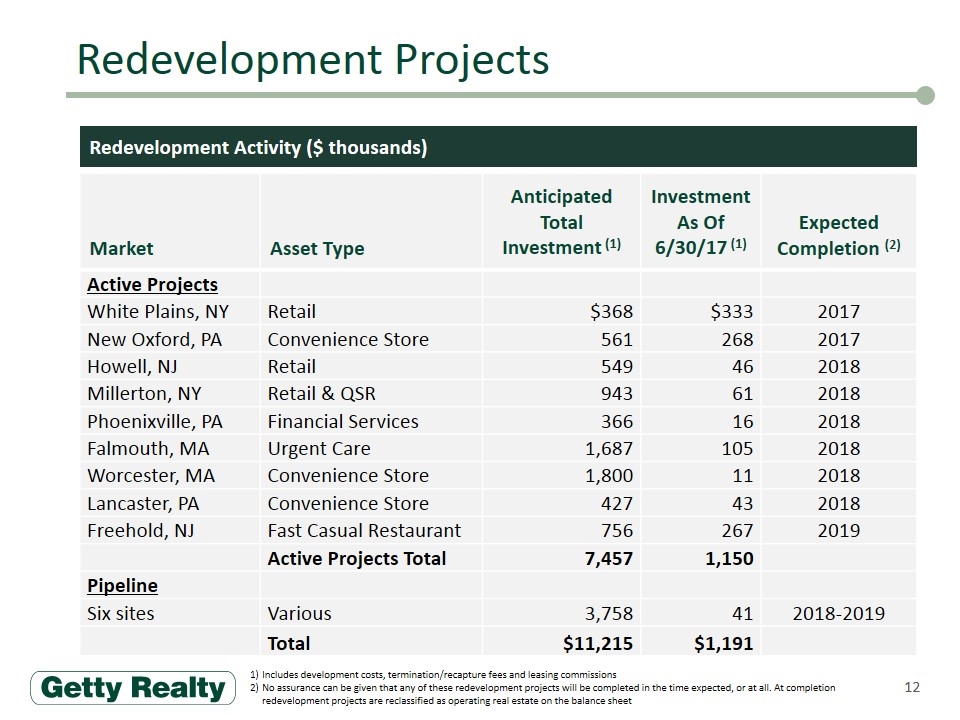
Market Asset Type Anticipated Total Investment (1) Investment As Of 6/30/17 (1) Expected Completion (2) Active Projects White Plains, NY Retail $368 $333 2017 New Oxford, PA Convenience Store 561 268 2017 Howell, NJ Retail 549 46 2018 Millerton, NY Retail & QSR 943 61 2018 Phoenixville, PA Financial Services 366 16 2018 Falmouth, MA Urgent Care 1,687 105 2018 Worcester, MA Convenience Store 1,800 11 2018 Lancaster, PA Convenience Store 427 43 2018 Freehold, NJ Fast Casual Restaurant 756 267 2019 Active Projects Total 7,457 1,150 Pipeline Six sites Various 3,758 41 2018-2019 Total $11,215 $1,191 Redevelopment Activity ($ thousands) Redevelopment Projects Includes development costs, termination/recapture fees and leasing commissions No assurance can be given that any of these redevelopment projects will be completed in the time expected, or at all. At completion redevelopment projects are reclassified as operating real estate on the balance sheet
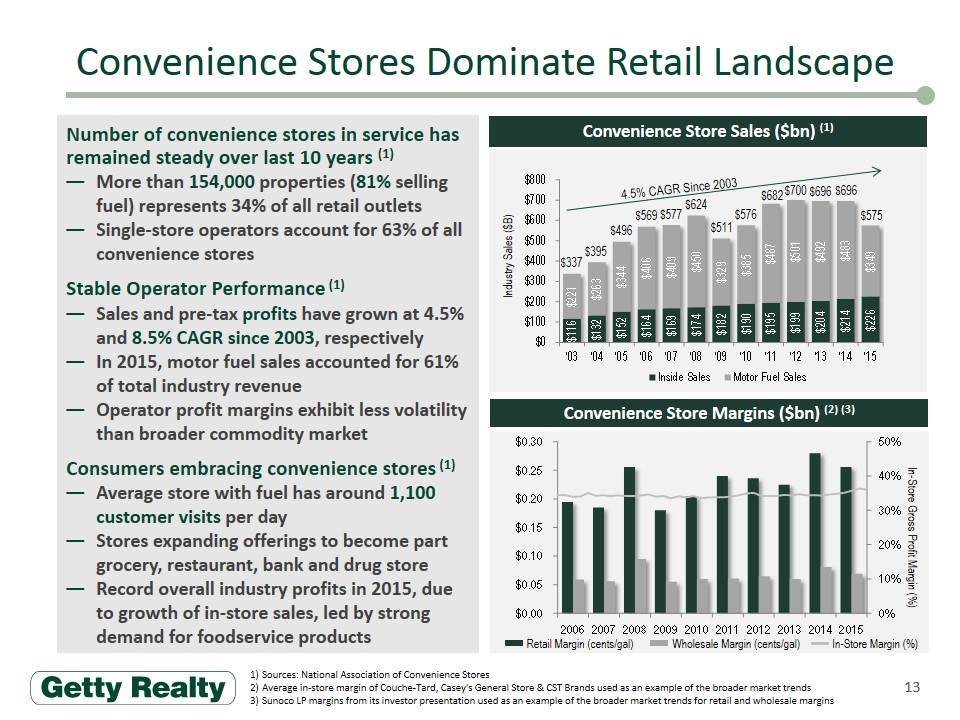
Number of convenience stores in service has remained steady over last 10 years (1) More than 154,000 properties (81% selling fuel) represents 34% of all retail outlets Single-store operators account for 63% of all convenience stores Stable Operator Performance (1) Sales and pre-tax profits have grown at 4.5% and 8.5% CAGR since 2003, respectively In 2015, motor fuel sales accounted for 61% of total industry revenue Operator profit margins exhibit less volatility than broader commodity market Consumers embracing convenience stores (1) Average store with fuel has around 1,100 customer visits per day Stores expanding offerings to become part grocery, restaurant, bank and drug store Record overall industry profits in 2015, due to growth of in-store sales, led by strong demand for foodservice products In-Store Gross Profit Margin (%) Retail Margin (cents/gal) Wholesale Margin (cents/gal) In-Store Margin (%) Industry Sales ($B) 4.5% CAGR Since 2003 $337 $395 $496 $569 $577 $624 $511 $576 $682 $700 $696 $696 $575 Convenience Stores Dominate Retail Landscape Convenience Store Margins ($bn) (2) (3) Convenience Store Sales ($bn) (1) Sources: National Association of Convenience Stores Average in-store margin of Couche-Tard, Casey's General Store & CST Brands used as an example of the broader market trends Sunoco LP margins from its investor presentation used as an example of the broader market trends for retail and wholesale margins

Financial Overview
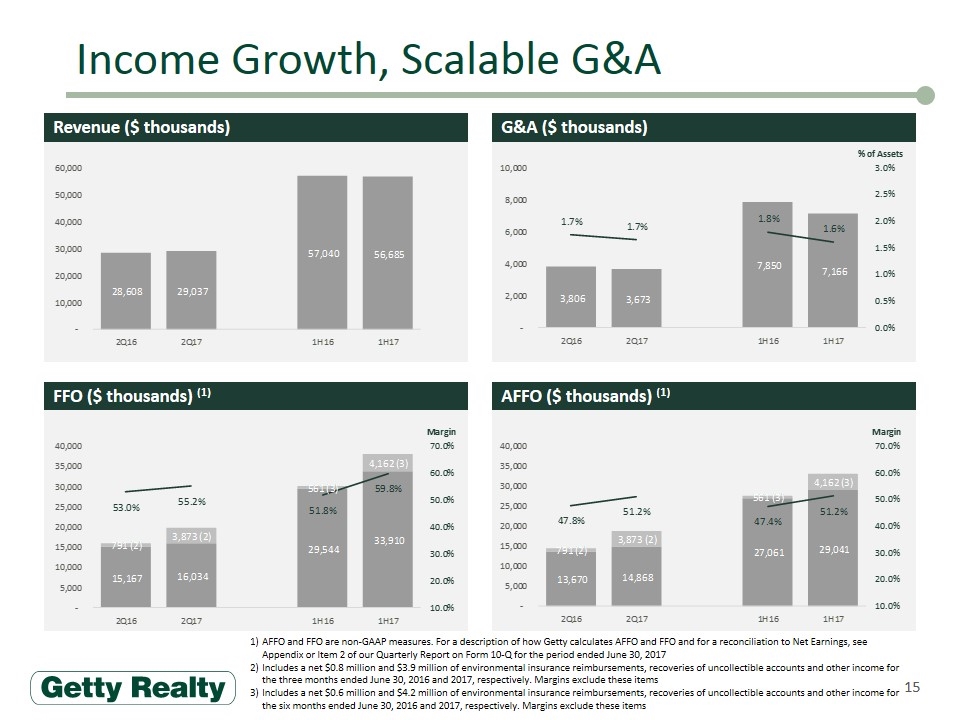
Income Growth, Scalable G&A AFFO and FFO are non-GAAP measures. For a description of how Getty calculates AFFO and FFO and for a reconciliation to Net Earnings, see Appendix or Item 2 of our Quarterly Report on Form 10-Q for the period ended June 30, 2017 Includes a net $0.8 million and $3.9 million of environmental insurance reimbursements, recoveries of uncollectible accounts and other income for the three months ended June 30, 2016 and 2017, respectively. Margins exclude these items Includes a net $0.6 million and $4.2 million of environmental insurance reimbursements, recoveries of uncollectible accounts and other income for the six months ended June 30, 2016 and 2017, respectively. Margins exclude these items G&A ($ thousands) AFFO ($ thousands) (1) Revenue ($ thousands) FFO ($ thousands) (1)
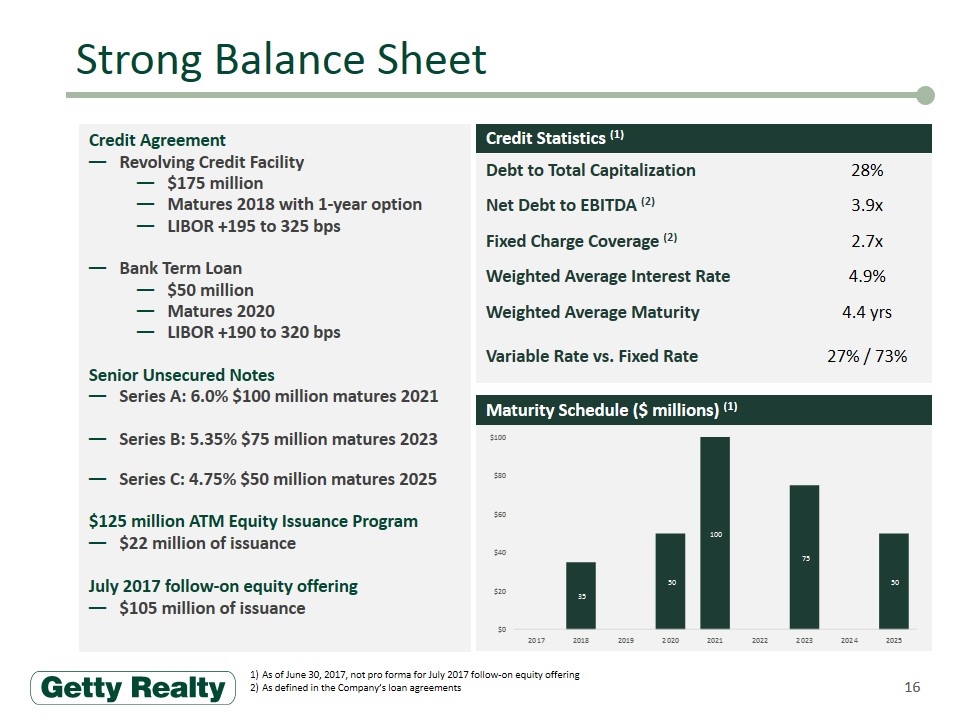
Strong Balance Sheet Credit Agreement Revolving Credit Facility $175 million Matures 2018 with 1-year option LIBOR +195 to 325 bps Bank Term Loan $50 million Matures 2020 LIBOR +190 to 320 bps Senior Unsecured Notes Series A: 6.0% $100 million matures 2021 Series B: 5.35% $75 million matures 2023 Series C: 4.75% $50 million matures 2025 $125 million ATM Equity Issuance Program $22 million of issuance July 2017 follow-on equity offering $105 million of issuance Credit Statistics (1) Maturity Schedule ($ millions) (1) Debt to Total Capitalization 28% Net Debt to EBITDA (2) 3.9x Fixed Charge Coverage (2) 2.7x Weighted Average Interest Rate 4.9% Weighted Average Maturity 4.4 yrs Variable Rate vs. Fixed Rate 27% / 73% As of June 30, 2017, not pro forma for July 2017 follow-on equity offering As defined in the Company’s loan agreements
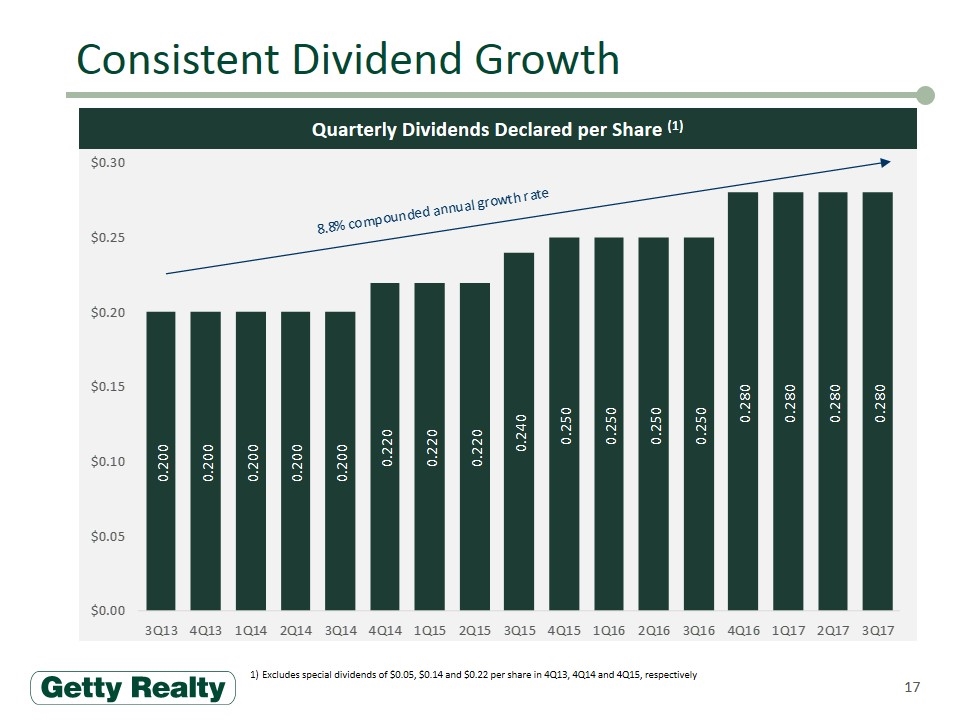
Quarterly Dividends Declared per Share (1) Consistent Dividend Growth Excludes special dividends of $0.05, $0.14 and $0.22 per share in 4Q13, 4Q14 and 4Q15, respectively
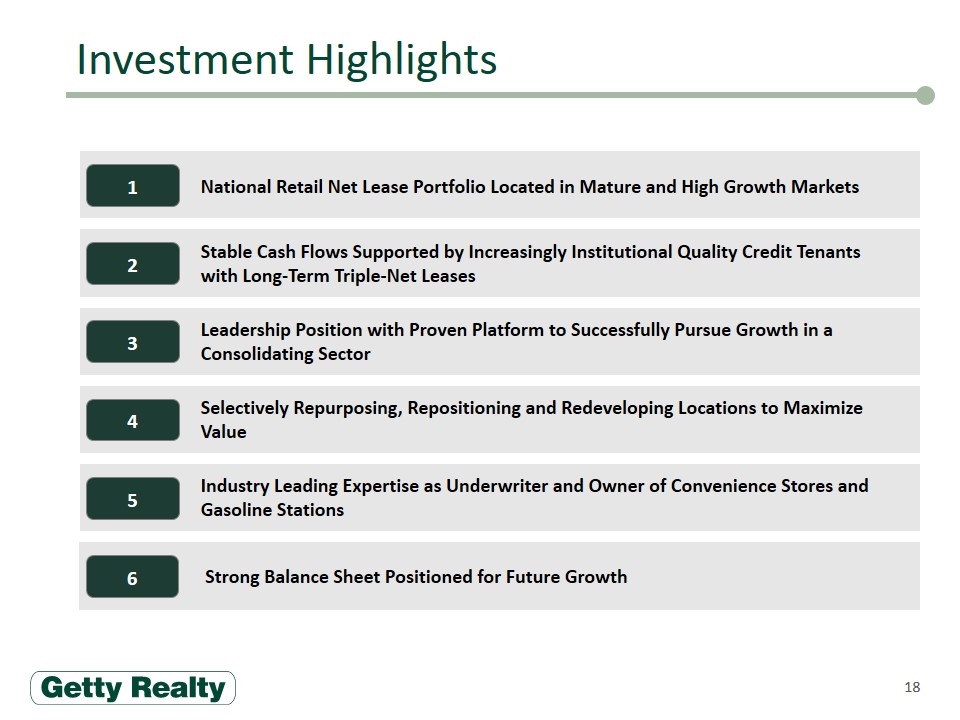
Investment Highlights 1 National Retail Net Lease Portfolio Located in Mature and High Growth Markets 2 Stable Cash Flows Supported by Increasingly Institutional Quality Credit Tenants with Long-Term Triple-Net Leases 5 Industry Leading Expertise as Underwriter and Owner of Convenience Stores and Gasoline Stations 3 4 Selectively Repurposing, Repositioning and Redeveloping Locations to Maximize Value 6 Strong Balance Sheet Positioned for Future Growth Leadership Position with Proven Platform to Successfully Pursue Growth in a Consolidating Sector

Appendix
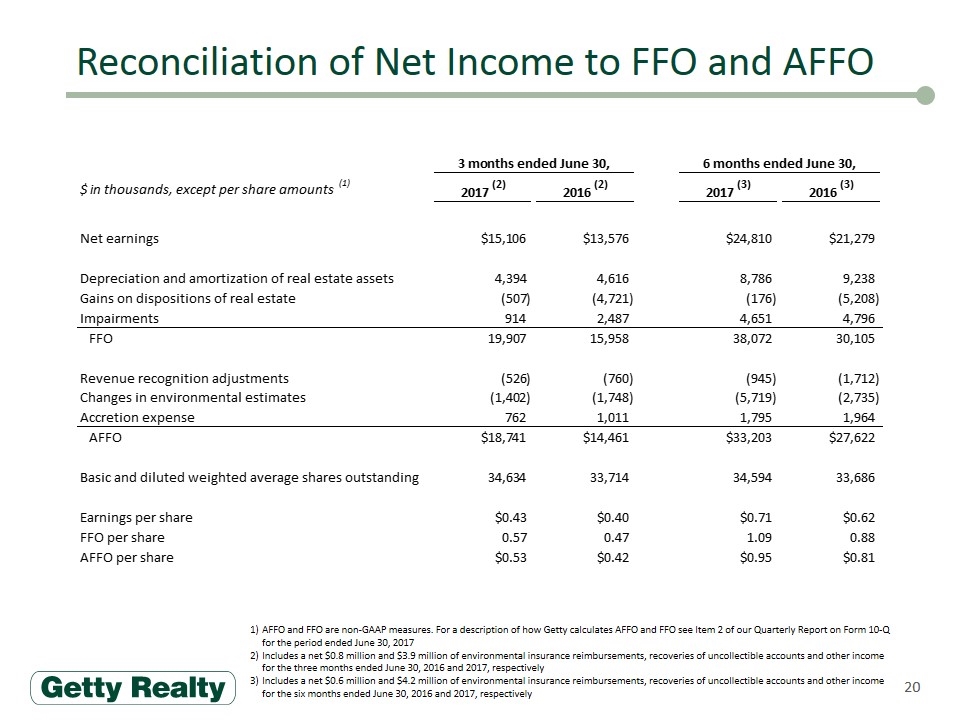
Reconciliation of Net Income to FFO and AFFO AFFO and FFO are non-GAAP measures. For a description of how Getty calculates AFFO and FFO see Item 2 of our Quarterly Report on Form 10-Q for the period ended June 30, 2017 Includes a net $0.8 million and $3.9 million of environmental insurance reimbursements, recoveries of uncollectible accounts and other income for the three months ended June 30, 2016 and 2017, respectively Includes a net $0.6 million and $4.2 million of environmental insurance reimbursements, recoveries of uncollectible accounts and other income for the six months ended June 30, 2016 and 2017, respectively
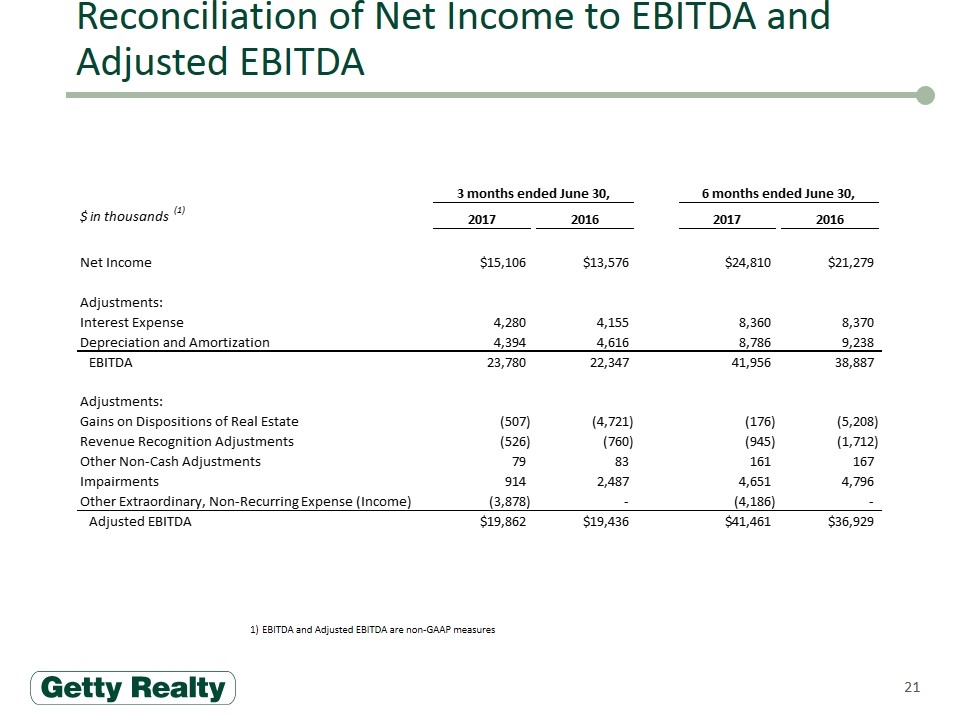
Reconciliation of Net Income to EBITDA and Adjusted EBITDA EBITDA and Adjusted EBITDA are non-GAAP measures
